Solarscope Index
![]() Distribution
Distribution
![]() News
News ![]() Notes & Interesting Articles
Notes & Interesting Articles
![]() Pricing
Pricing
![]() Products
Products
![]() Warranty & Service
Warranty & Service

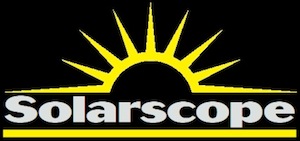
SOLARVIEW (SV): DEDICATED SOLAR TELESCOPES BY SOLARSCOPE LTD.
Not suitable for viewing objects other than the Sun
![]() Solarview SV-60 60mm Aperture Hydrogen Alpha Filtered f/8 Telescope Optical Tube Assembly
Solarview SV-60 60mm Aperture Hydrogen Alpha Filtered f/8 Telescope Optical Tube Assembly
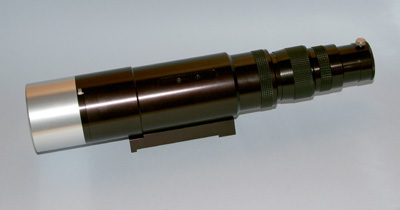 The Solarview Ltd. SF/DSF series of Fabry-Perot etalon based filters have become known among the more astute in our astronomy community as the 'Rolls-Royce' and 'Ferrari' of this class of hydrogen-alpha solar filters. The SF/DSF are filter sets that rely on the customer (or Company Seven) to provide a suitable telescope optical tube. There is some assembly required of the systems in the field, only minutes really, but there are customers who want to go out and observe quickly and for comparatively brief sessions. These are people who really value ease of setup and portability above all else; and they would rather pay a premium for a superbly constructed portable solar telescope that is handy enough to travel with instead of paying less for a much larger solar telescope that may show no more in terms of actual solar definition. These are the clientele for which the Solarview (SV) series solar telescopes were developed to satisfy. So the proof is there for anyone to see, these offer an impressive balance of easy portability and fine results, and that are attainable by those on the budget of mere mortals.
The Solarview Ltd. SF/DSF series of Fabry-Perot etalon based filters have become known among the more astute in our astronomy community as the 'Rolls-Royce' and 'Ferrari' of this class of hydrogen-alpha solar filters. The SF/DSF are filter sets that rely on the customer (or Company Seven) to provide a suitable telescope optical tube. There is some assembly required of the systems in the field, only minutes really, but there are customers who want to go out and observe quickly and for comparatively brief sessions. These are people who really value ease of setup and portability above all else; and they would rather pay a premium for a superbly constructed portable solar telescope that is handy enough to travel with instead of paying less for a much larger solar telescope that may show no more in terms of actual solar definition. These are the clientele for which the Solarview (SV) series solar telescopes were developed to satisfy. So the proof is there for anyone to see, these offer an impressive balance of easy portability and fine results, and that are attainable by those on the budget of mere mortals.
Right: Solarview SV50 solar telescope (34,645 bytes).
The take anywhere SV-50 provides 50mm of unobstructed aperture which delivers a high contrast image full of intricate detail. Its larger brother, the SV-60, is still extremely portable and yet provides an extra 10mm of aperture in a slightly longer package. Although 10mm may not sound much, it means that the SV-60 has 40% more area than the SV-50 and therefore delivers images which show even finer detail and with notably brighter views too. Because of the additional light throughput of the SV-60, at similar working magnifications the SV-60 will allow you to employ faster shutter speeds thus improving the chances of freezing the better moments of atmospheric steadiness. So Company Seven recommends the SV-60 over the SV-50 for our customers who may pursue imaging (film, digital, or video) applications.
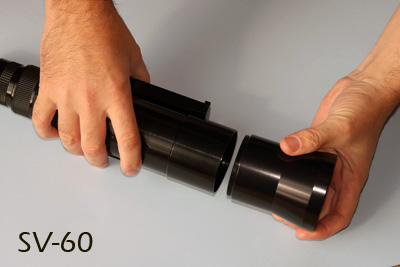 Both the SV50 and SV60 instruments are built upon achromatic objective lenses with a focal ratio of f/8. Being achromatic lenses, the degree of color correction is not as critical to a solar telescope that transmits light only in one narrow portion of the spectrum; what is more critical is that the quality of the figure, polish and antireflection coatings of the lens are good. So the SV-50 provides a working focal length of 400mm while that of the SV-60 is 480mm. Basically speaking, if you used the same eyepiece with both scopes then the SV-60 would show an view that is 20% larger in terms of magnification. But either telescope is still capable of operating at comparatively moderate magnifications, this is particularly beneficial during observing (or imaging) sessions where the atmospheric steadiness conditions are poor as this can minimize the visual impact of scintillations. Of course either telescope is capable of operating at the higher magnifications too, well high enough to not only fill the eyepiece or camera with the full disc of the Sun but close in on particular regions of activity.
Both the SV50 and SV60 instruments are built upon achromatic objective lenses with a focal ratio of f/8. Being achromatic lenses, the degree of color correction is not as critical to a solar telescope that transmits light only in one narrow portion of the spectrum; what is more critical is that the quality of the figure, polish and antireflection coatings of the lens are good. So the SV-50 provides a working focal length of 400mm while that of the SV-60 is 480mm. Basically speaking, if you used the same eyepiece with both scopes then the SV-60 would show an view that is 20% larger in terms of magnification. But either telescope is still capable of operating at comparatively moderate magnifications, this is particularly beneficial during observing (or imaging) sessions where the atmospheric steadiness conditions are poor as this can minimize the visual impact of scintillations. Of course either telescope is capable of operating at the higher magnifications too, well high enough to not only fill the eyepiece or camera with the full disc of the Sun but close in on particular regions of activity.
Left: Solarview SV60 solar telescope showing extension section (34,645 bytes).
The additional tube length required for the SV-60 to achieve f/8 is provided by an extension piece which assembles onto the main tube body. This quick and easy to assemble extension, allows the SV-60 to be carried around in the same size carrying case as the SV-50 even while retaining its greater image scale.
The etalons used in both scopes have a bandpass of 0.7 Angstroms which makes them ideal for viewing both surface and prominence detail. A thumbwheel tilt mechanism is provided to allow you to adjust the tuning of the etalon slightly. This may come in useful to study material which has been ejected from the Sun's surface at such a speed that the light it emits has been (Doppler) shifted slightly away from the main h-alpha wavelength.
All optical coatings are ultra-hard, this means that they will not degrade over time as softer coatings can.
For proof of concept simply look at some of the images of the Sun taken with the Solarscope SV-50 telescope by Ninian Boyle:
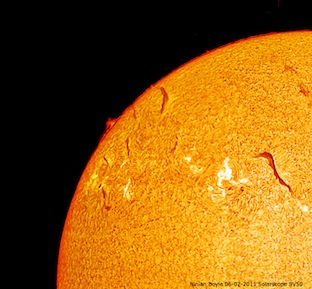 Prominence and flares, 2 Jun 2011 Solarscope SV-50 (40,623 bytes). Click on image to see enlarged view (220,858 bytes) |
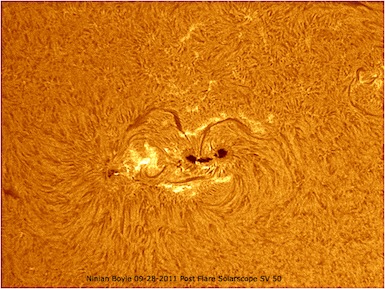 Sunspot, 28 Sept 2011 Solarscope SV-50 (67,509 bytes). Click on image to see enlarged view (520,939 bytes) |
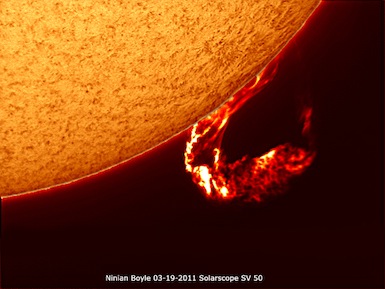 Looping Prominence, 19 March 2011 Solarscope SV-50 (39,170 bytes). Click on image to see enlarged view (345,565 bytes) |
INCLUDED WITH EACH SV TELESCOPE:
SV Mounting Hardware:
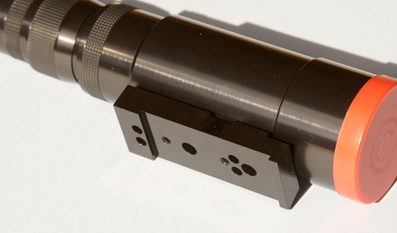 A telescope is made up of two major components: the optical tube assembly that dictates what you can see, and the mount and tripod or pier that determine how you can employ the telescope optical tube: for visual and/or imaging applications. The SV-50 and SV-60 optical tube assemblies are provided with a versatile mounting plate attached at their base. As well as incorporating a number of popular standard tripod threads for direct mounting on a photographic tripod head, including ¼ inch - 20 tpi, the precisely machined aluminum plate will also fit onto many platforms made specifically to accommodate telescopes. The compatible choices include the TeleVue 'Telepod' series 'alt-az' heads, or you may slide the SV telescope onto the saddles of many astronomical German Equatorial Mounts. So you will have a choice of supporting your SV telescope atop any number of compact to moderate sized mounts that accommodate the popular dovetail plate standard popularized since the 1980's by Vixen, Celestron, and Orion.
A telescope is made up of two major components: the optical tube assembly that dictates what you can see, and the mount and tripod or pier that determine how you can employ the telescope optical tube: for visual and/or imaging applications. The SV-50 and SV-60 optical tube assemblies are provided with a versatile mounting plate attached at their base. As well as incorporating a number of popular standard tripod threads for direct mounting on a photographic tripod head, including ¼ inch - 20 tpi, the precisely machined aluminum plate will also fit onto many platforms made specifically to accommodate telescopes. The compatible choices include the TeleVue 'Telepod' series 'alt-az' heads, or you may slide the SV telescope onto the saddles of many astronomical German Equatorial Mounts. So you will have a choice of supporting your SV telescope atop any number of compact to moderate sized mounts that accommodate the popular dovetail plate standard popularized since the 1980's by Vixen, Celestron, and Orion.
Right: Solarview SV solar telescope showing the provided Dovetail Mounting Plate (31,913 bytes).
There will not be many accessories needed for these solar telescopes because most of what you need will be here. But to make the telescope useful you will need some tripod and mount head. We invite you to contact Company Seven, preferably by telephone or by E-Mail, to discuss what may best suit your lifestyle and goals.
TeleVue 'Sol-Searcher':

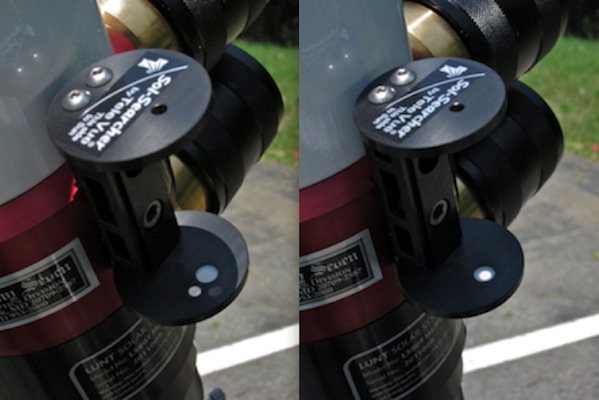
Above: TeleVue Sol-Searcher kit along side an SV telescope, and at right shown attached to a solar telescope and ready to go, and at right showing
the Sun's disc projected onto the black back plate, and then shown with the Sun properly centered on the Sol-Searcher sight (47,815 bytes and 79,822 bytes).
Finding the Sun by just pointing a telescope by eye is a potentially dangerous exercise, and at times when the sunlight is diffused by thin clouds one cannot rely on seeing a shadow cast by the telescope onto the ground to guide the telescope precisely onto the Sun. So TeleVue Optics developed the Sol-Searcher: a safe, compact and comparatively inexpensive accessory specifically made to help you quickly point a telescope right onto the Sun Once fitted, the device projects a circular disc of sunlight onto a small white circular screen at the rear of the finder; if the finder is aligned to the Solarview scope then positioning the disc in the centre of the screen means that the Sun will also be in the centre of the telescope's field of view. It is a snap to use!
And every new Solarview SV telescope includes this simple to fit and easy to use TeleVue Sol-Searcher solar finder. The Allen Wrench and bolts to fit and adjust the finder are included in the package.
SPECIFICATIONS OF THE SV SERIES TELESCOPES
Model Designation: |
||
Focal length |
||
Focal Ratio |
||
Objective Lens Design |
||
Objective Aperture |
||
Operating Wavelength |
||
Bandpass |
||
Etalon Coating |
||
Anti-reflective Coating |
||
Thermal stability |
||
Focuser Diameter |
||
Length Overall |
||
Weight (complete telescope assembly) |
||
Included Accessories |
||
Included Dovetail Plate |
* Company Seven can provide a custom and ATA shipping-approved custom case specifically tailored for your SV telescope and any accessories you wish to carry (camera, adapters, eyepieces, etc.).
Contents Copyright 2012-2013 Company Seven, Ninian Boyle, & Solarscope Ltd. - All Rights Reserved

